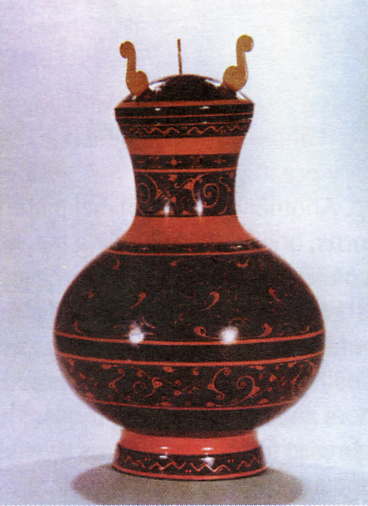| Art Q&A > Crafts |
|
|
Lacquerware
Chinese ancestors began to make lacquerware about 7,000 years ago. In 1978, red lacquer bowls and tubes of the Hemudu Culture were found in Yuyao, Zhejiang Province. According to scientific analysis, the coatings are natural lacquers.
Lacquerware was, however, usually coated black and decorated with red designs or coated red and decorated with black designs. About 220 lacquerware objects were unearthed in Zeng Houyi's Tomb in Hubei Province. They are the earliest and most superb lacquerware of the Chu Kingdom of the Warring States Period. Lacquerware items, including clothing storage boxes, which were unearthed in the tomb, are richly varied, of large size and simple style; they reflect the charm of the culture of the Chu Kingdom. The designs on some of the boxes make them very valuable. In the center of one is a Zhuan calligraphy character, meaning a star, surrounded by the names, also in Zhuan characters, of the phases of the moon in a circle. On the two ends are designs of a blue dragon and a white tiger. This box is a rare relic of great value for research into ancient Chinese astronomy as it is the earliest written record of moon phases yet found in China.
Some lacquerware was painted with fairy tales. For example, the ancient Chinese tale of Hou Yi Shooting the Sun was painted on a black coated and red design clothing box. Mushroom-shaped and colored clouds and two twisting double headed snakes with human faces form the background. On the two sides are two trees, the tall one with 11 branches and the short one with nine. On the tip of each branch is a circle radiating brilliant light, symbolizing the sun. Between the two trees, a man shoots an arrow at a bird on the tall tree. The story demonstrates mankind's successful battle against nature.
The patterns on the lacquerware are simple lines or complicated pictures, depending on the items' different functions. The contrast between the black and red colors creates a special artistic effect. The black and red pictures on the lacquerware present a mysterious and ever-changing fairy world inhabited by human beings and immortals. |
||||||
All rights reserved. Reproduction of text for non-commercial purposes is permitted provided that both the source and author are acknowledged and a notifying email is sent to us. |
||||||
 |

